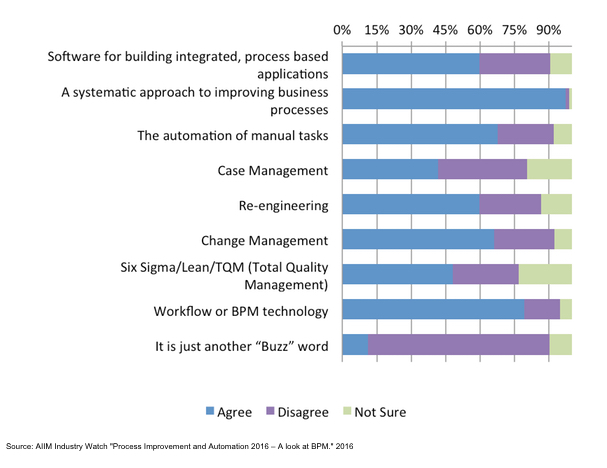
Image by: Infografx, ©2017 Getty Images
When I talk with folks about workflow issues, the focus of discussion typically turns to technology or the potential use of it. Until we understand the underlying reasons for the issue, technology alone will not resolve it completely and, in fact, has amplified the issue in some cases. My point is that in order to address workflow issues, organizations need to be aware of and embrace the concept that process management and automation are about more than just the technology.
It is evident that this awareness is growing and taking hold, as shown in the 2016 AIIM Industry Watch report titled “Process Improvement and Automation 2016 – A look at BPM.” In this report, we find that “the majority of respondents see BPM as the combination of a systematic approach to improving business processes (97%) and workflow or BPM technology (79%), while 66% see BPM as change management.”

In AIIM's recent Industry Watch report, respondents define what business process management (BPM) means to them.
Where to Begin
This is where I say, "Go with the flow." The same study shows that “stuck-in-process is the biggest operational problem for 58% of respondents.” The question to ask is, "Why is the process getting stuck?"In order to answer that question, you have to look at the process flow, document what is really happening (not what people think is happening), and identify the root cause of the problem. In other words, it is time to map the process in the current state and then determine how to improve it. Once the improvements are made and the problems corrected, perhaps it is time to apply technology to enhance it.
In My View
There are many out there who would argue that this is "old school" and that technology is available to help document the current state. I do not disagree, but the fundamental point is still relevant here: Until we can document reality and identify the cause of the problem, we cannot improve properly and could create additional issues.By going with the flow, assessing reality, documenting the steps, players and content, and uncovering the root cause, we can make a well-informed decision on corrective actions to take. Additionally, process mapping helps communicate with the organization on what is happening, how it can be resolved, and serves to engage the user community, which, in turn, helps with change management when the time comes to implement those changes. It is not enough to know there is a problem; you have to know the cause, and going with the flow as a starting point is one of the best ways to approach this.
For more information on process management, don't miss AIIM's Executive Workshop, "Automating Business Processes for Digital Transformation: AIIM’s BPM Specialist Course," on Wednesday, May 3 at DSF ’17 in Downtown Chicago.
Bob Larrivee is Vice President and Chief Analyst of Market Intelligence at AIIM and an internationally recognized subject matter expert and thought leader with over 30 years of experience in the fields of information and process management. Follow him on Twitter @BobLarrivee.
















